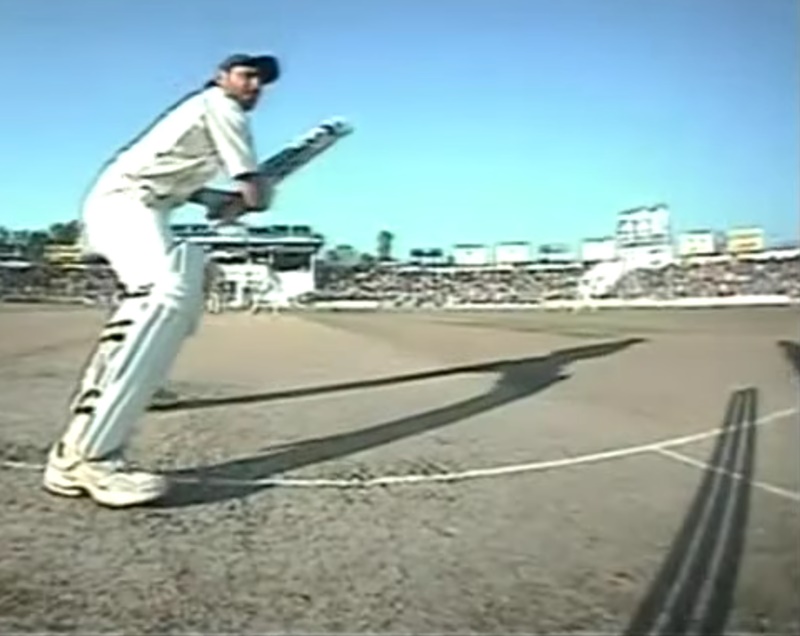Big thanks to everyone who funds King Cricket via our Patreon campaign. We couldn’t justify spending this much time on our features without you.
We already know all of the wrong things people are going to say about this article.
- Some people will say that Shahid Afridi wasn’t a great batsman, which is entirely missing the point
- Some will say that he was actually a bowler really, which is again very much missing the point
- Others will say that he was a good T20 batsman, but unsuited to Tests, which is missing the point so spectacularly we almost want to cry
It is all about context.

The year is 2020. So too is most of cricket these days. We live in an age of reckless batting – only it’s not actually reckless at all.
Modern sloggery is dictated by circumstance. It’s a logical thing to do. Players hit fours and sixes with abandon because, in the shortest format, that is a very big part of the way a team goes about winning games.
It is an approach that has bled into the longer formats too. Highly aggressive batting has become a tactic coldly deployed by batsmen when they feel that circumstances demand that.
This is all well and good, but a side-effect of our increased exposure to boundaries is that it has tragically eroded the shocking impact of someone batting like a complete idiot.
The franchise age has greatly diminished Shahid Afridi, a batsman who strove so very hard to get the absolute least out of his talent.
Here are five innings that explain why he was so fantastic.

102 off 40 balls against Sri Lanka in Nairobi in 1996
It is worth revisiting and recontextualising Shahid Afridi’s first innings in international cricket.
In December 1982, Zaheer Abbas made a 72-ball hundred in a rain-affected 33-over game against India. At the time, it was the fastest hundred in one-day internationals.
Abbas’s record stood until December 1988 when Mohammad Azharuddin reached three figures against New Zealand in 62 balls.
No-one topped that until April 1996 when Sanath Jayasuriya reached 100 in 48 balls against Pakistan.
Then, in October of that same year, Shahid Afridi came to the crease for the very first time and made a hundred in 37 balls.
That is, by any stretch, an insane thing to do. The first time he batted, Shahid Afridi knocked 11 balls off the fastest hundred record. That alone makes the idea of him as a batsman eternally appealing.
We could end the article here and it would make sense. Our central point that Shahid Afridi is a batsman worth celebrating would have been made, because a world where something like that doesn’t happen is a far more boring world indeed.
To give some sense of how freakish Afridi’s innings was in that era (and even in the one that followed), his record stood for almost 18 years until Corey Anderson bettered it by just one ball. To this day, AB de Villiers is still the only batsman to have gone faster than Anderson.
Now consider also that Afridi was only 16 when he played his innings. For most of the years afterwards, we all went, “Oh yeah, 16, I’m sure he was,” because that’s what you say whenever a Pakistan cricketer does something incredible at a ludicrously young age.
But then earlier this year it was being reported that Afridi would play in the inaugural season of the Hundred at the age of 40.
So maybe he really was 16.
141 off 191 balls against India in Chennai in 1999
Afridi has quite the record against India in Tests. He made 709 runs in eight Tests at 47.26 and scored at a run a ball.
The Chennai hundred is the big one though, really.
For two days the match meandered along at three runs an over with Pakistan’s 238 followed by India’s 254. At this point Afridi, opening the batting, larruped 141, of which 102 were scored in boundaries. The rest of the team mustered 145 between them and Pakistan won by 12 runs.
People say Afridi wasn’t a Test batsman, but he won a Test match against India with his batting and that’s quite an important thing.
59 off 59 balls against India in Kolkata in 2005

You could probably make a case for Pakistan’s 2005 tour of India being peak Afridi.
He missed the first Test, which was drawn, and came in as opener for the second.
India made 407 in the first innings, built around a crisp and dogged near-five-hour hundred from Rahul Dravid. Our man surveyed this, digested the information, and then slapped 29 off 21 balls. His final shot was a hoick to mid-on.
This is important. There’s this notion that Afridi was some sort of T20 trailblazer, but it really wasn’t like that. No-one ever looked at Afridi and thought to themselves, ‘that’s the way to go’. His approach wasn’t ahead of its time. He was just a complete outlier.
India made 407-9 in their second innings, built around an even more steadfast Dravid hundred. They declared with 20 overs to go on day four.
Pakistan needed 422 to win, but the pitch and required run rate said that a draw was a sensible and credible target. A draw was the thing to go for.
Afridi was out before the close of play for a run-a-ball 59.
Pakistan were left needing 327 on that final day. They didn’t really know what to do and eventually settled on losing by 195 runs.
As a postscript to this, in the next Test, Afridi was out in the second over of the match for a golden duck and then made 58 off 34 balls in the second dig to set up a declaration ahead of a Pakistan win.
He was stumped off the bowling of Sachin Tendulkar in that innings, which is a magnificent way to get out.
122 off 95 balls against the West Indies in Bridgetown in 2005
This was not the easiest pitch.
In the first innings Brian Lara and his backlift made a hundred and Shivnarine Chanderpaul made 92. Those two were pretty handy batsmen who were batting when the pitch was at its best. No-one else passed 28.
Pakistan’s reply was 144 all out with Afridi contributing 16 off 15 balls as opener. We can’t be bothered looking up the exact details of the dismissal, but he was caught by Fidel Edwards, which doesn’t exactly scream ‘classical dismissal’.
The West Indies decided to bat again. Chris Gayle and Wavell Hinds scraped fifties, Lara made 48 and Chanderpaul made 153 not out.
Afridi batted at six in the second innings. He emerged at 47-4 and from that entirely promising position he made what was at the time the ninth fastest Test hundred in history. Pakistan lost.
31 off 15 balls against Australia at Lord’s in 2010

This was Afridi’s final Test and his first as captain. That is the kind of sentence you only get to write about Pakistani cricketers.
Nominally the home team, Pakistan were playing in England for security reasons and Afridi had been brought back as captain after Mohammad Yousuf had been handed an indefinite ban.
He responded with a true captain’s innings.
Australia made 253 and Afridi came in at seven with his team in a bit of trouble. He calmly assessed the situation before making a gloriously pointless and inappropriate 31 off 15 balls.
In the second innings, he was caught on the boundary by Mike Hussey from his fourth delivery.
It was one of the purest examples of Afridi being incapable of moderating his batting and in a way it enhances all that came before it.
Afridi never altered his approach and being as his approach amounted to little more than essaying wild, body-convulsing heaves at pretty much every delivery he faced, the fact that he managed to score a bunch of Test hundreds and average 36.51 is nothing short of a miracle.
His one-day record is 95 per cent dogshit and five per cent dynamite – 10 of his fifties came in 23 balls or fewer. This was borne of a mentality where if he had 50 overs to make 30 runs and his own life hinged on the outcome, he’d still try and get there in five shots.
The mere possibility he might succeed with the bat breathed life into a great many otherwise very boring games. It made him a very valuable human caveat.
Writing for All Out Cricket, back when that magazine existed, we put it like this:
“Picture it as a Butch and Sundance type situation where the remaining batsmen are holed up in some shed, surrounded by foes. They take inventory of their weaponry and find they have two pistols, a shotgun and not all that much ammunition.
“At this point, Shahid Afridi reveals that he has his own private airforce, but isn’t quite sure whether anyone’ll be manning the phones today when he tries to get hold of them.”
Mostly no-one was manning the phones.
But every now and again someone was.
If you enjoy King Cricket – in particular these features – and feel it’s worth a quid (or the cost of a pint) each month, you can become a patron here. Put simply, the more patrons we get, the more we can do.



He is also one of only two Pakistani batsmen to have a song by an Irish chamber pop duo written about him.
His living room has one of the most unapologetic “me” walls I’ve seen.
He has been an ornament to cricket. An anti-Kallis.
Shahid Afridi.
Along with Mr Miandad?
Never had the pleasure of seeing The Duckworth Lewis Method (did they ever tour?) or the Divine Comedy, but I did catch Pugwash supporting The Bluetones a few years back.
I saw the Duckworth Lewis Method in Norwich a few years ago. Splendid evening.
I am suitably envious Edwardian. In my mind’s eye there’s is always three gorgeous backing singers, in tight sequinned dresses with a prominent hip curve singing “you gotta put the ball where it has to be , in the corridor of uncertainty”. Judging from YouTube the reality was slightly different, but they did seem to have Matt Berry guesting for them which would be ample compensation.
He is a loveable rogue isn’t he? You’ve written him well KC.
This article seems like it’s appeared a few times in different forms over the years, but it doesn’t get any less true.
Sometimes it’s good to draw everything together and try and do the job properly.
Even as an Indian, always… Shahid Afridi. I grew up watching Imran Khan hold aloft the world cup and Javed being a d**k, Inzy smoothing them through cover, but the game wasn’t won till we got Afridi.
I saw a lot of that Chennai hundred, an afternoon of increasing incredulity, and each run was a dagger to the heart. Death by 141 cuts, Wasim got Dravid in an Akram-esque 2 ball spell, Sachin made his way to 136, and we lost the match by 12 runs.
And they still have Sachin MotM
Love this piece, KC.
I was there for Day Three of Afridi’s sole test captaincy outing, but sadly did not in person witness him bat in that match.
http://ianlouisharris.com/2010/07/15/a-day-of-neutral-test-cricket-at-lords-australia-v-pakistan-day-three-with-paul-deacon-mat-tim-15-july-2010/
I think I did get to see those Afridi batting performances on the TV. I had organised my work the day before and after my attendance, as oft I do/did, to be “morning heavy”, allowing me to catch half a day’s play on the TV without jeopardising my so-called career.
Shahid Afridi was always box office. Infuriating but so watchable. Mat (aka The Tasmanian Devil) who joined us on Day Three would always refer to Shahid as “Mad Dog Afridi”. Mat had a point.
Sadly I never got to witness a day of Afridi when someone was manning those air force phones. My only memories are the commentators saying something along the lines of “Pakistan are in trouble but you can’t rule them out with Afridi still to come” followed two overs later with something like “well that’s their last hope gone”.
I saw Shahid Afridi perform once in the flesh at the SCG in early 2005. He came to the crease with Pakistan at a relatively healthy 4 for 240 something, and promptly hit Shane Warne into the Ladies Stand. He watched a wicket fall and departed shortly thereafter caught in the outfield off Stewie MacGill for a pulsating 12 off 9 balls, including another boundary. Pakistan were suddenly 6 down and on their way to being taken to the cleaners. Magnificent stuff…
Textbook.
Contra-textbook in my case.
I only ever saw Shahid Afridi bat once in a test match: right at the end of Day Three of the Lord’s test in 2006. Daisy and I took the Duchess with us that day, so we will have sat out the day until after the last ball was bowled.
https://www.espncricinfo.com/series/14612/scorecard/225255/england-vs-pakistan-1st-test-pakistan-tour-of-england-and-scotland-2006
The scorecard tells us that Afridi scored 17 runs off 20 balls in that innings, which spanned Day Three and Day Four. Worse, from my point of view, the scorecard also tells us that Afridi was 0* overnight, so we only saw him block. He faced seven dot balls before stumps that evening.
What on earth was he thinking?
We were just thinking about what it must have been to be one of the bowlers for that first ODI innings. What must have been going through their heads 25 balls in when this teenage debutant was on about 75?
Its not just the bowlers. Its everyone watching the game. Extreme feats of scoring seem to have a tendency to bamboozle 🙂
Going back to before Afridi’s debut, when Tendulkar scored 82 off 50 odd balls against New Zealand, the broadcasters had no idea what was going on. I remember India was chasing a fairly small target (around 150 or so) and the broadcasters were going absolutely nuts about the fact that the run rate was 8 runs per over. They were projecting scores of 400 and all that (which was silly given the tiny target).
Oh and I forgot to mention, excellent piece KC. Glad I read it 🙂
Cheers Aditya.
Afridi was always one of my favourites to watch. He batted like a third team club cricketer, trying to larrup every ball into the stands, no matter the situation. Maybe nine times out of ten it would be a glorious failure, but that one match would make it all worth it. Well, not for the team, who’d doubtless rather not have snatched defeat from the jaws of victory repeatedly, but for Afridi himself and for me, absolutely worth it.
I knew I would enjoy this but I enjoyed it a bit more than I expected, thank you!
We don’t talk enough about the pressure – and motivation? – to perform with the bat after breaking a world record 100 as a bowler in your first ODI and then making a match-winning 100 in your first innings as a young Pakistani against India in India.
Yeah but you know, he wasn’t a great batsman, more of a bowler really, and more of a T20 player who was unsuited to tests.
He also missed a lot at point.